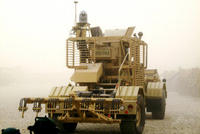-
Regulating geo-engineering schemes
With policymakers and political leaders increasingly unable to combat global climate change, more scientists are considering the use of manual manipulation of the environment to slow warming’s damage to the planet; some legal scholars argue that the legal ramifications of this kind of geo-engineering need to be thought through in advance and a global governance structure put in place soon to oversee these efforts
-
-
Ninth-grader wins award for solar-powered water purification system
Ninth-grader Deepika Kurup of Nashua High School in New Hampshire won $25,000 and named America’s Top Young Scientist for her innovative new water-purification system; her prototype, which harnesses solar energy to disinfect contaminated water, can help improve the lives of the 1.1 billion people around the world who lack access to clean drinking water
-
-
UV offers hope for safer drinking water
Recent changes in the Environmental Protection Agency’s (EPA) surface water treatment rules mandate, among other things, more aggressive monitoring and control of various pathogens, notably including Cryptosporidium; this microbe, which can cause severe illness or death, is highly resistant to chlorine-based disinfection practices; as one means to reducing the threat, the EPA has called for treating water with ultraviolet (UV) radiation, which also serves as a “secondary barrier” to inactivate (prevent reproduction of) other key pathogens such as adenovirus and other viruses, as well as bacteria and parasites such as Giardia
-
-
Laws of traditional physics would foil Santa's effort to carry out mission
Santa has 31 hours to visit 378 million Christian children; at the rate of 3.5 children per household, and assuming at least one good child per home, this comes to 108 million homes; if each child receives no more than a medium sized Lego set (two pounds), the sleigh would be carrying more than 500 thousand tons, not counting Santa himself; Santa would thus need at least 360,000 Reindeer to pull the sleigh; since Santa must visit 108 million homes in 31 hours, he will have to travel at 650 miles per second — 3,000 times the speed of sound; at that speed, the lead pair of Reindeer would absorb 14.3 quintillion joules of energy per second each and vaporize — indeed, the entire Reindeer team would be vaporized within 4.26 thousandths of a second; Santa himself would be subjected to forces of 17,500 Gs; a 250 pound Santa (which seems ludicrously slim) would be pinned to the back of the sleigh by 4,315,015 pounds of force, and be crushed
-
-
Army engineers develop new roadway threat detection system

Explosives along roadways remain an unrelenting hazard for deployed soldiers; U.S. Army engineers have developed a system for detecting possible threats by identifying potential threat locations on unimproved roads; the system can perform region of interest cueing of threats at greater standoff distances, which can be further interrogated by the radar as the vehicle gets closer to the threat
-
-
Maintaining robust communications in congested and contested environments
Radios are used for a wide range of tasks, from the most mundane to the most critical of communications, from garage door openers to military operations’ as the use of wireless technology proliferates, radios and communication devices often compete with, interfere with, and disrupt the operations of other devices; a new DARPA challenge is looking for innovative approaches that ensure robust communications in such congested and contested environments
-
-
What we know, and what we can do, about school shootings
Since the early 1970s, school shootings at American elementary, secondary, and higher education institutions have been a painful reality for American society; after each incident — like the recent attack in Newtown, Connecticut — there is voluminous dialogue about what can be done to prevent the next such tragedy; a new study explores what we have learned about these tragic incidents, and what can be done to prevent them
-
-
Bricks made from paper waste

Spanish researchers have mixed waste from the paper industry with ceramic material used in the construction industry; the result is a brick that has low thermal conductivity meaning it acts as a good insulator; its mechanical resistance, however, still requires improvement
-
-
Some geo-engineering approaches to combat climate change may not work
Numerous geo-engineering schemes have been suggested as possible ways to reduce levels of the greenhouse gas carbon dioxide in the atmosphere and so reduce the risk of global warming and climate change; one such technology involves dispersing large quantities of iron salts in the oceans to fertilize otherwise barren parts of the sea and trigger the growth of algal blooms and other photosynthesizing marine life; seeding the oceans with iron, however, may not address carbon emissions
-
-
Sandy relief bill says rebuilding effort should take into consideration climate-related risks
The $60 billion Sandy relief bill being debated this week in the Senate does not specifically mention the words climate change or global warming, but it implicitly raises topics and themes which are part of the climate change discussion; the bill says that federal, state, and local agencies engaged in the post-Sandy rebuilding effort should take into consideration “future extreme weather events, sea level rise and coastal flooding”
-
-
Innovative Atmospheric Vortex Engine for energy generation
A Canadian company offers a new energy generation concept: the Atmospheric Vortex Engine (AVE) uses low-temperature waste heat to create a tornado-like atmospheric vortex; in contrast with a real tornado, the vortex cannot go anywhere because it is anchored to its heat source. So it is really more like a dust devil or waterspout, and it serves as a low-cost virtual chimney
-
-
Fuels, household chemicals made from sugar
Scientists at the University of Manchester have identified a biocatalyst which could produce chemicals found in ice-cream and household items such as soap and shampoo — possibly leading to the long-term replacement of chemicals derived from fossil fuels
-
-
Encouraging science research, study among minorities

A study published last year, in which 83,000 grant applications from 2000 through 2006 were examined, found that African American scientists were far less likely therethan white scientists to obtain research money from the National Institute of Health (NIH); NIH is setting up a program to change that
-
-
Connection between goth subculture, mass shootings appears tenuous

Classmates of the otherwise bland and elusive Adam Lanza, who last Friday killed twenty children and six adults at the Sandy Hook school in Newton, Connecticut, described him as “goth”; is there a “goth” connection in the Newtown school shooting? The question is asked because news reports have connected several perpetrators of both mass shooting and killing on a smaller scale to goth culture; a closer examination shows that the relationship between goth and mass shooting is tenuous
-
-
NRA shuts down Facebook page in wake of Connecticut shooting
In the immediate aftermath of the Newtown shooting, the National Rifle Association (NRA) has deactivated its Facebook page, just one week after celebrating the fact that it has gathered 1.7 million “likes” on the page; the debate about whether the United States needs stricter gun controls continues, though
-
More headlines
The long view
New Technology is Keeping the Skies Safe
DHS S&T Baggage, Cargo, and People Screening (BCP) Program develops state-of-the-art screening solutions to help secure airspace, communities, and borders
Factories First: Winning the Drone War Before It Starts
Wars are won by factories before they are won on the battlefield,Martin C. Feldmann writes, noting that the United States lacks the manufacturing depth for the coming drone age. Rectifying this situation “will take far more than procurement tweaks,” Feldmann writes. “It demands a national-level, wartime-scale industrial mobilization.”
How Artificial General Intelligence Could Affect the Rise and Fall of Nations
Visions for potential AGI futures: A new report from RAND aims to stimulate thinking among policymakers about possible impacts of the development of artificial general intelligence (AGI) on geopolitics and the world order.
Smaller Nuclear Reactors Spark Renewed Interest in a Once-Shunned Energy Source
In the past two years, half the states have taken action to promote nuclear power, from creating nuclear task forces to integrating nuclear into long-term energy plans.
Keeping the Lights on with Nuclear Waste: Radiochemistry Transforms Nuclear Waste into Strategic Materials
How UNLV radiochemistry is pioneering the future of energy in the Southwest by salvaging strategic materials from nuclear dumps –and making it safe.
Model Predicts Long-Term Effects of Nuclear Waste on Underground Disposal Systems
The simulations matched results from an underground lab experiment in Switzerland, suggesting modeling could be used to validate the safety of nuclear disposal sites.
